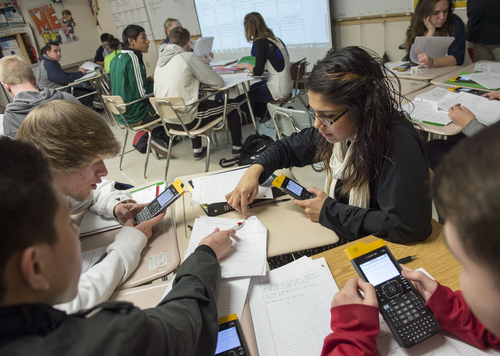This is an archived article that was published on sltrib.com in 2014, and information in the article may be outdated. It is provided only for personal research purposes and may not be reprinted.
In recent weeks, some politicians have claimed that Utah has finally done it — moved out of last place in per-pupil spending.
"In case you didn't hear, UT [Utah] no longer has the lowest per-pupil total spending for public ed," state Auditor John Dougall proclaimed on his Facebook page.
Then, in late July, Sen. Howard Stephenson, R-Draper, announced to legislative leadership at a public Education Task Force meeting, "Idaho now holds the once-coveted position that we held for so long that none of us were real proud of."
It's an assertion that, if true, could shape the conversation about public education funding in Utah.
The trouble is, it's not totally accurate.
A May report released by the U.S. Census Bureau does indeed rank Utah as second to last (beating Idaho) for per-pupil revenue in 2012, at $7,607 per student.
The problem is — that's revenue, not spending.
That same report shows that when it came to "current spending" per pupil, Utah still ranked last in the nation, at $6,206 per student in fiscal year 2012.
What's the difference? The revenue figure shows how much schools got from federal, local and state sources per student. The spending figure shows how much schools actually doled out per kid.
Stephen Wheeler, a survey statistician with the Census Bureau, said it's generally more accepted to look at that spending column when citing per pupil spending.
"In the last few years, Utah has been last and still is for this year," Wheeler said.
Bruce Williams, associate superintendent for business and operations at the state Office of Education, also said he'd tend to look at the spending side when describing per-pupil spending.
"That's what's actually been spent, as opposed to revenue," Williams said.
Dougall, however, stands by his statement. He said he feels it's more accurate to look at the per-pupil revenue ranking than the spending one when discussing per pupil funding.
That's because the spending figure doesn't include money spent building new schools — a big expense in growing Utah.
"We're a rapidly growing state," Dougall said. "We have to build lots of new school buildings. That's part of our cost of education, so to ignore that part of spending is unfair versus, say, a state that's shrinking."
He also said to dismiss the revenue side would be "ignoring a big effort taxpayers are making in the state."
Stephenson said after taking another look at that census report, he'd clarify that Utah is no longer last in per-pupil revenue but still last in spending.
He also said, however, that Utah has doubled that per-pupil spending, when dollars are adjusted for inflation, since 1976.
Plus, he said Utah is efficient with its education dollars, with lower administrative costs than most other states.
"Money or spending is not a direct reflection of the quality of education," Stephenson said.
Dougall also said the rankings ultimately only mean so much.
"At the end of the day it's not really how many dollars you spend," Dougall said. "It's how well you spend the money, that's what really matters anyway."
Nationally, the average amount spent per student in 2012 was $10,608, according to that census report, with New York spending the most, at $19,552 per pupil.
Utah students score at about the national average on National Assessment of Educational Progress exams in fourth-grade math and reading and eighth-grade math.
Utah students score above the national average in eighth-grade reading and fourth- and eighth-grade science.
The National Center for Education Statistics (NCES) also tracks per pupil spending per state, and according to NCES, Utah ranked last in the nation for per pupil spending in fiscal year 2011 at $6,326 per pupil.
NCES' report for fiscal year 2012 is expected at the end of August.



